Spiegel report: Rivers and lakes are reaching historic lows, and large areas of land have dried up. The extreme summer in the northern hemisphere can also be seen from space.
The summer of 2022 was unprecedented with its extreme weather across much of the northern hemisphere. “Almost a third of the Northern Hemisphere was affected by drought,” says Omar Baddour, head of the Climate Monitoring Division at the World Meteorological Organization (WMO). “It was very unusual.”
From Southeast Asia to China, the U.S., Africa and Europe, heat and drought records have been set everywhere. Forests have burned in regions that would otherwise know little risk of forest fires. Fields wither and crops fail, drinking water has become scarce in some places. The drama can also be seen from space.
Drought in large parts of Germany
Satellite images from the private operator Planet show, for example, the unusually low water level of the Rhine near Düsseldorf this summer compared with August last year (see slider below). Germany’s most important inland waterway has consistently made headlines for low water in recent weeks.
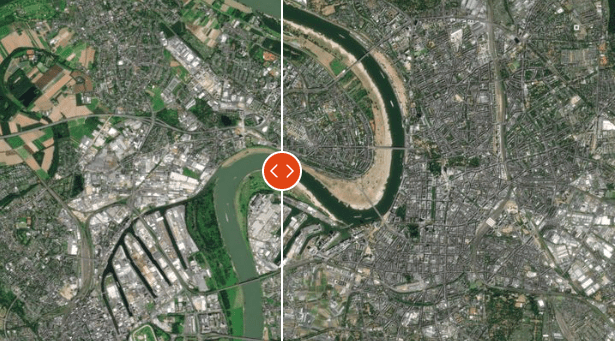
In mid-August 2022, the water level at Kaub in Rhineland-Palatinate had dropped below the 40-centimeter mark. The value there is considered an important indicator of the fairway depth of the river. Navigation was temporarily impaired.
The fact that rivers dry up is usually mainly due to a lack of precipitation – in some cases already in winter. High temperatures and solar radiation can then exacerbate the problem because they contribute to more water evaporating than coming in.
According to preliminary calculations by the German Weather Service (DWD), Germany experienced one of the sunniest, hottest and driest summers since records began. The DWD has been recording sunshine duration since 1951, and temperatures and precipitation since 1881. “We are thus likely to have experienced a soon-to-be typical summer in times of climate change,” says DWD meteorologist Uwe Kirsche.

To date, large parts of Germany have been affected by exceptional drought. The drought monitor of the Helmholtz Centre for Environmental Research (UFZ) records, among other things, the moisture of the total soil (about 1.8 meters). The map currently appears everywhere in the warning colors yellow to dark red, which stand for “unusually dry” to “exceptional drought” (see GIF above).
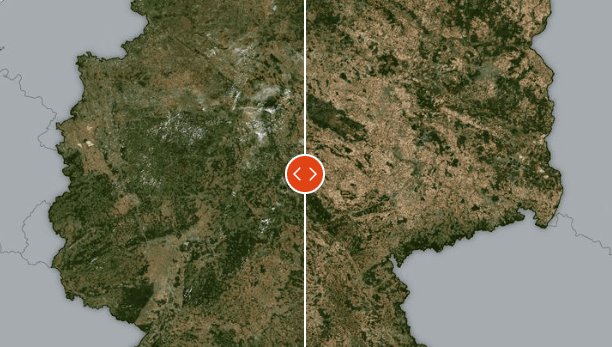
Planetary satellite images from the summers of 2021 and 2022 show how Germany’s appearance has changed compared to July of the previous summer. There is a lack of lush greenery, and vast areas have dried out because the vegetation can no longer find enough water in the soil.
Severe drought in southern Europe
Many states in southern Europe are also suffering from major drought. According to the government, France experienced the worst drought ever recorded, with more than a hundred municipalities temporarily without drinking water. Agricultural irrigation was restricted.
In Spain, reservoir levels dropped to 36.9 percent, according to government figures. According to the media, this is the lowest level since at least 1995. Dozens of Spanish municipalities rationed drinking water.

Italy experienced one of the hottest summers in the past 40 years. The Po River carried less water than at any time since records began. Images from the Esa “Sentinel-2” satellites show the river in June of 2020 to 2022 (see GIF above).
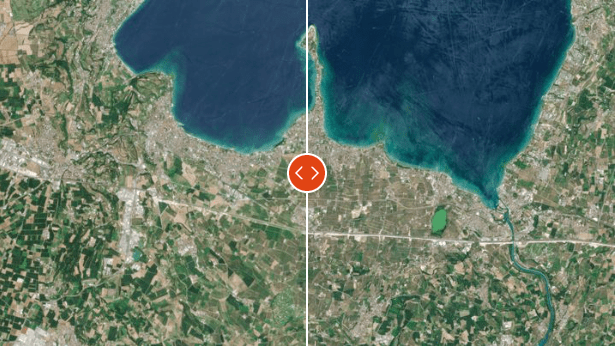
The water level of Lake Garda reached its lowest level in 15 years in mid-August. Planet shows the southern part of the body of water around the tourist resort of Santa Maria di Lugana in July 2021 and July 2022 in comparison (see slider above). The vegetation around the lake has also dried up significantly.
Concern about the great salt lake
Around the world, things often don’t look any better. The southwestern U.S. in particular has recently experienced unusual drought, some of it extreme. 2022 also had the third warmest July since records began 128 years ago. Only in July 1936 and 2012 were the average temperatures higher.
Affected by heat and drought, according to the U.S. National Oceanic and Atmospheric Administration (NOAA), are regions where about 172 million people live, more than 55 percent of the population. Here, too, many rivers and reservoirs have very little water.
In July, for example, Utah’s Great Salt Lake, the largest of its kind in the Northern Hemisphere, reached an all-time low. Water levels have been recorded since about the mid-19th century.
The Great Salt Lake has been shrinking for decades, in part because water from rivers and streams that feed the lake is being diverted to fields and residential areas. The extreme drought in the southwestern U.S. this summer now did the rest. A satellite image from the European Space Agency (Esa) shows the loss of large parts of the water body since 1985.
According to the US Geological Survey, the lake has lost almost half of its surface area compared to the historical average. About 2000 km² of lake bottom has been exposed – an area as large as Tenerife. Compared to its 1987 peak, the lake now contains only a little more than a quarter of the water it did. As a result, salinity is also rising, threatening wildlife.
Drought threatens power supply
Drying riverbeds also occurred in China. The Yangtze is the country’s longest and most important river, supplying water to more than 400 million people. This summer, however, the Yangtze basin received 45 percent less water than usual, reports Esa . Sections of the main river and dozens of tributaries dried up. Sichuan province gets 80 percent of its energy from hydropower. Electricity became scarce there.
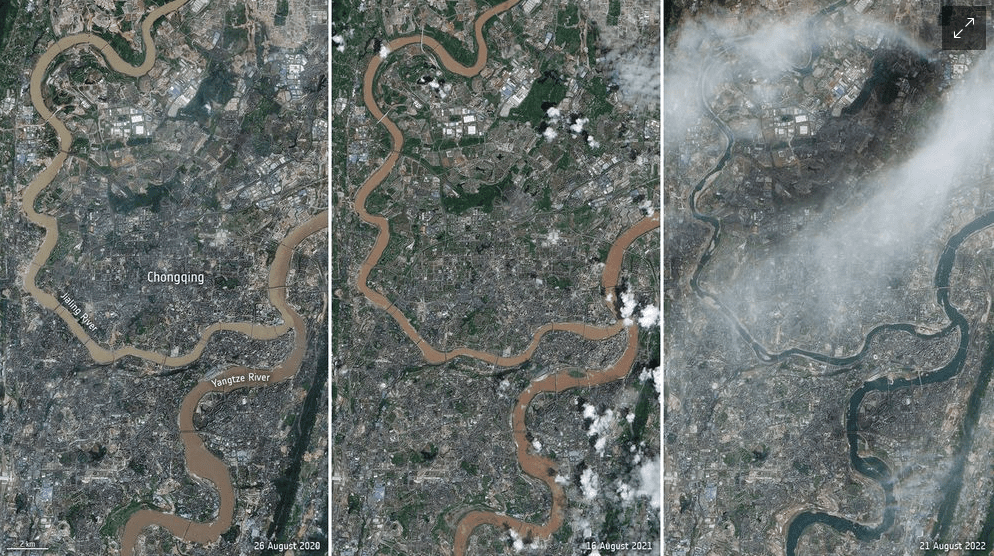
Images from the “Sentinel-2” satellites from this year and the past two years show particularly low water levels in the Yangtze (see series of images above). It is also noticeable that the river looks cleaner. This is not a good sign, however, but the result of sediment being transported out of the riverbed, attenuated by the low level.
The drought in the Yangtze basin also affects Lake Poyang, China’s largest freshwater lake (see slider below). That its size varies between summer and winter seasons is normal. In winter, the water level is typically low; in summer, fed by the Yangtze River, it rises significantly.
In the summer of 2022, however, the phenomenon of the swelling water level was absent, reported the American space agency Nasa .
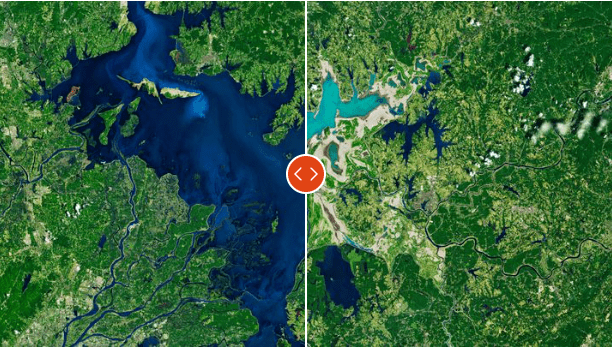
The lake reached its highest water level of the season in June 2022 and entered the dry phase as early as the beginning of August – about a hundred days earlier than normal. Since records began in 1951, the lake has never reached such a low water level earlier. The level continues to drop today.
After the drought comes the flood
“There have always been weather extremes,” says WMA specialist Baddour. “But what is clear is that they are becoming more frequent and more severe in intensity due to climate change.” In addition to extreme drought, these extremes include flooding.
In Pakistan, for example, extreme and unusually early heat in April and May was recently followed by devastating flooding. Pakistan had almost three times as much rain in August as the average of the past 30 years, reports the WMO. Millions of people lost their belongings, more than 700,000 livestock died, and millions of tons of crops failed.
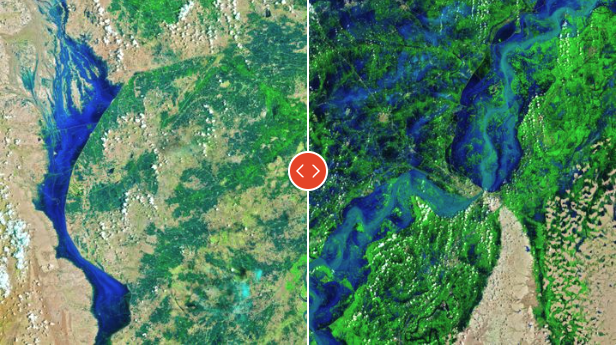
One of the worst hit by the summer monsoon is the province of Sindh. Nasa’s Landsat 8 and Landsat 9 satellites imaged the region around Lake Hamal on August 4 and 28, 2022 (see slider above). The false-color images show high water in deep blue.
Also contributing to the calamity is the melting of some 7000 glaciers in Pakistan. The country hosts most of the glacial ice outside the polar regions, and it is melting there as well. In northern Pakistan, rain and meltwater have recently turned slopes into raging torrents.




